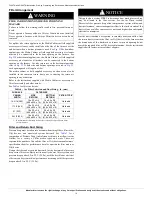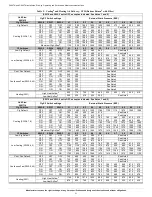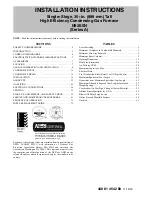
F96VTN and G96VTN: Installation, Start-up, Operating and Service and Maintenance Instructions
Manufacturer reserves the right to change, at any time, specifications and designs without notice and without obligations.
6
A12182
Fig. 4 – Prohibited Installations
CODES AND STANDARDS
Follow all national and local codes and standards in addition to these
instructions. The installation must comply with regulations of the
serving gas supplier, local building, heating, plumbing, and other codes.
In absence of local codes, the installation must comply with the national
codes listed below and all authorities having jurisdiction.
In the United States and Canada, follow all codes and standards for the
following:
A93044
Fig. 5 – Installation in a Garage
Safety
• US: Current edition of National Fuel Gas Code NFPA 54/ANSI
Z223.1 and the Installation Standards, Warm Air Heating and Air
Conditioning Systems ANSI/NFPA 90B
• CANADA: Current edition of National Standard of Canada, Natural
Gas and Propane Installation Code (NSCNGPIC) CAN/CSA B149.1
General Installation
• US: NFPA 54/ANSI Z223.1 and the NFPA 90B. For copies, contact
the National Fire Protection Association Inc., Batterymarch Park,
Quincy, MA 02269; or for only the NFPA 54/ANSI Z223.1 contact the
American Gas Association, 400 N. Capitol, N.W., Washington DC
20001
• CANADA: NSCNGPIC. For a copy, contact Standard Sales, CSA
International, 178 Rexdale Boulevard, Etobicoke (Toronto), Ontario,
M9W 1R3, Canada
Combustion and Ventilation Air
• US: Section 9.3 of the current edition of NFPA54/ANSI Z223.1 Air
for Combustion and Ventilation
• CANADA: Part 8 of the current edition of CAN/CSA B149.1, Venting
Systems and Air Supply for Appliances
Duct Systems
• US and CANADA: Air Conditioning Contractors Association
(ACCA) Manual D, Sheet Metal and Air Conditioning Contractors
National Association (SMACNA), or American Society of Heating,
Refrigeration, and Air Conditioning Engineers (ASHRAE)
Fundamentals Handbook
Acoustical Lining and Fibrous Glass Duct
• US and CANADA: Current edition of SMACNA, NFPA 90B as tested
by UL Standard 181 for Class I Rigid Air Ducts
Gas Piping and Gas Pipe Pressure Testing
• US: Current edition of NFPA 54/ANSI Z223.1; Chapters 5, 6, 7, and 8
and national plumbing codes.
CANADA: Current edition of CAN/CSA-B149.1, Parts 4, 5, 6, and 9.
In the state of Massachusetts:
• This product must be installed by a licensed plumber or gas fitter.
• When flexible connectors are used, the maximum length shall not
exceed 36 in. (914 mm).
• When lever type gas shutoffs are used they shall be T-handle type.
• The use of copper tubing for gas piping is not approved by the state of
Massachusetts.
Electrical Connections
• US: Current edition of National Electrical Code (NEC) NFPA 70.
• CANADA: Current edition of Canadian Electrical Code CSA C22.1
Condensate Drain Connection
• US: Current edition of National Standard Plumbing Code, Section 8.7.
• Canada: Current edition of National Plumbing Code of Canada.
ELECTROSTATIC DISCHARGE (ESD)
PRECAUTIONS PROCEDURE
1. Disconnect all power to the furnace. Multiple disconnects may be
required. DO NOT TOUCH THE CONTROL OR ANY WIRE
CONNECTED TO THE CONTROL PRIOR TO DISCHARGING
YOUR BODY’S ELECTROSTATIC CHARGE TO GROUND.
2. Firmly touch the clean, unpainted, metal surface of the furnace
chassis which is close to the control. Tools held in a person’s hand
during grounding will be satisfactorily discharged.
WARNING
!
FIRE, INJURY OR DEATH HAZARD
Failure to follow this warning could result in personal injury, death
and/or property damage.
When the furnace is installed in a residential garage, the burners and
burner ignition devices must be located at least 18 in. (457 mm) above
the floor. The furnace must be located or protected to avoid damage by
vehicles. When the furnace is installed in a public garage, airplane
hangar, or other building having a hazardous atmosphere, the furnace
must be installed in accordance with the current edition of NFPA
54/ANSI Z223.1 or CAN/CSA B149.2. See
BACK POSITIONED
DOWNWARD
AIR RETURN
CUT IN BACK
BACK POSITIONED
UPWARD
18-IN. (457.2 mm)
MINIMUM TO BURNERS
CAUTION
!
FURNACE RELIABILITY HAZARD
Failure to follow this caution may result in unit component damage.
Electrostatic discharge can affect electronic components. Take
precautions during furnace installation and servicing to protect the
furnace electronic control. Precautions will prevent electrostatic
discharges from personnel and hand tools which are held during the
procedure. These precautions will help to avoid exposing the control to
electrostatic discharge by putting the furnace, the control, and the
person at the same electrostatic potential.







































